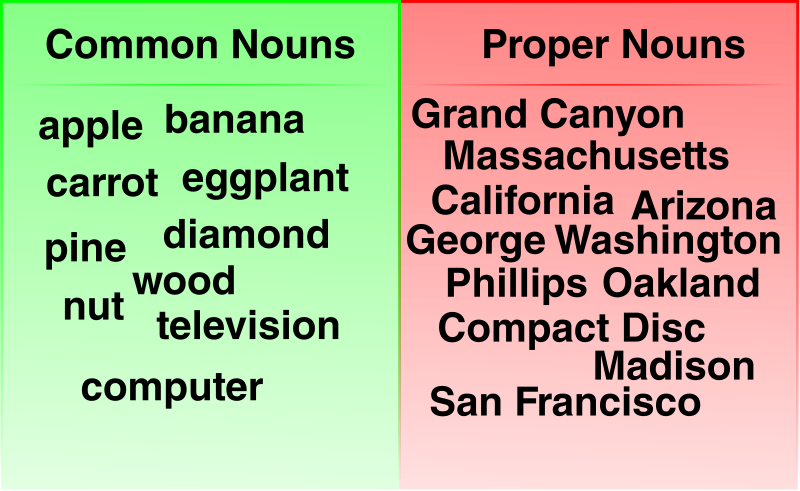However, noun is not a semantic category, so it cannot be characterized in terms of its meaning. Thus, actions and states of existence can also be expressed by verbs, qualities by adjectives, and places by adverbs. Many different types of nouns exist, including proper and common nouns, collective nouns, mass nouns, and so forth.
Proper nouns are specific types of nouns that are also called proper names. While common nouns start with a lowercase letter, proper nouns start with a capital letter. Learn more about proper nouns, how to identify them, and how to use them through definitions and examples. The names of school subjects are typically common nouns. School subjects that are the names of languages, such as English or German, are proper nouns and should be capitalized. The names of specific courses are proper nouns and should be capitalized.
Below are some examples showing what should be capitalized and what should not. Students of English grammar classes are often confused by the difference between common nouns and proper nouns. Simply put, a proper noun is capitalized while a common noun is not. View a few examples of common and proper nouns before breaking these grammar concepts down. Remember, a proper noun is a specific, unique person, place, thing, or idea. Unlike common nouns, proper nouns are almost always capitalized.
This is true whether they begin a sentence or not. Los sustantivos propiosor Spanish proper nouns are the ones we use to name things or people such as Ana, Carlos, México, Brasil, Toyota and so on . What makes them easy to differentiate from common nouns is the fact tht proper nouns will always begin with capital letter as you can see in the sentences in the list.
All nouns serve to name a person, place, or thing. Those that identify general people, places, or things are called common nouns—they name that which is common among others. Proper nouns, on the other hand, are used to identify an absolutely unique person, place, or thing.
A proper noun names someone or something that is one of a kind, which is signified by the use of a capital letter, no matter where it appears in a sentence. Linguists often prefer to define nouns in terms of their formal properties. Such definitions may nonetheless still be language-specific since syntax as well as morphology varies between languages.
If you are trying to determine if a word is a common or proper noun, look at the capitalization. Is the noun capitalized in the middle of a sentence? Things are trickier if the noun is the first word in the sentence. In that case, ask yourself if the noun is referring to a specific person or thing. If it isn't, you are instead looking at a common noun. A good rule of thumb is that all names and titles are proper nouns and will always be capitalized.
Remember, proper nouns are specific people, places, things, or ideas. Since they represent a concrete or specific person, place, thing, or idea, they are capitalized.For example, book is a generic common noun. The most straightforward way of understanding the relationship between common and proper nouns is to think about proper nouns as specific examples of common nouns. A proper noun is a specific, unique person, place, thing, or idea.
Many European languages use a cognate of the word substantive as the basic term for noun (for example, Spanish sustantivo, "noun"). Nouns in the dictionaries of such languages are demarked by the abbreviation s. Instead of n., which may be used for proper nouns or neuter nouns instead. In English, some modern authors use the word substantive to refer to a class that includes both nouns and noun phrases . It can also be used as a counterpart to attributive when distinguishing between a noun being used as the head of a noun phrase and a noun being used as a noun adjunct.
For example, the noun knee can be said to be used substantively in my knee hurts, but attributively in the patient needed knee replacement. These common nouns become proper nouns when named. For example, boy becomes Thomas, river becomes the Thames River and monument becomes the Washington Monument. It wouldn't make sense to have sentences with only common nouns because you wouldn't know exactly what something was. However, you also wouldn't want to put proper nouns in every sentence. This is especially true if you don't know who or what something is.
So, common and proper nouns are used together in sentences to make them more enjoyable and easier to understand. The English language is unique in what it considers to be common and proper nouns, and there are special rules in place to help you identify both. Read on to learn more about the difference between common and proper nouns, how to use them correctly and how to come up with your own examples. Examples of count nouns are chair, nose, and occasion.
Lexical categories are defined in terms of the ways in which their members combine with other kinds of expressions. The syntactic rules for nouns differ between languages. In English, nouns are those words which can occur with articles and attributive adjectives and can function as the head of a noun phrase. "As far as we know, every language makes a grammatical distinction that looks like a noun verb distinction." Now that you know the difference between common and proper nouns, test your ability to accurately identify common nouns. Countries are a type of nouns, whereas nationalities are adjectives.
You use proper nouns in sentences the same way you use common nouns, but they retain their capitalization whether or not they come at the beginning of a sentence. Explore what sentence examples look like with proper nouns. Common nouns refer to a class of entities - like cities, planets, corporations, etc - that represent unspecific, non-unique nouns. In contrast, a proper noun is a noun that refers to a unique entity, a unique representation of the common noun, such as Paris, a unique city.
Remember that they always need to be written in capital letters . Awesome, let's take a step closer towards unraveling the mystery of proper nouns. Just like in English, nouns in Spanish may be categorized as common or proper, count or mass, singular or plural.
Unlike in English, Spanish nouns are also categorized as either masculine or feminine. In English we have proper nouns , abstract nouns , countable nouns (book – books), collective nouns , etc. As in English, Spanish proper nouns are typically capitalized.
Examples of proper nouns include Casa Blanca , Enrique , Panamá , and Torre Eiffel . Some nouns can be either common or proper, depending on the context. For example, Luna is a proper noun when referring to the moon that circles the Earth , while luna is a common noun when it refers to a planetary satellite in general. The difference is that "videocámara" is compound noun which is formed by the words (video + cámara) and it is functioning as the direct object in the sentence. AMIGO on the other hand is the subject of the sentence.
The four types of nouns in Spanish we have studied so far are the ones we encourage you to remember. However, there are still more specific types of nouns in the language that you might want to study as well, including simple and compound nouns. Here are the remaining types and a list of Spanish nouns belonging to each category. Both common and proper nouns are used in most of our sentences.
Let's find out what proper nouns are all about in this lesson. We will first briefly learn about nouns, and then learn to distinguish between common nouns and proper nouns. You've still got your proper nouns (María), abstract nouns , countable nouns (el libro – los libros) and collective nouns (panal, archipiélago). This is what you are going to master in the next few minutes of reading. In this sentence, New World, Pocahontas, John Rolfe, and England are all proper nouns because they are specific names or titles.
When a noun is specific like this, it is proper and must be capitalized. In this sentence, people, government, underground, companies, land, and house are all common nouns because they are not specific names or titles. Now that you understand what common and proper nouns are, let's review how and when to use them, and how to tell them apart! Remember, every proper noun has a common noun counterpart, but not every common noun has a related proper noun. In this sentence, we see examples of common nouns, such as doctor, hours, and common cold.
Additionally, the sentence has an example of a proper noun– Memorial Hospital. These examples are all proper nouns since they are specific, unique examples of the common noun building. Generally, we can more vividly picture or understand a text when the author uses examples of proper nouns since there is less room for interpretation. A proper noun or proper name is a noun representing unique entities , as distinguished from common nouns, which describe a class of entities .
What Does Common Noun Mean In Spanish Let's test to see if you have mastered common and proper nouns. Read the following sentences and see if you can figure out if the nouns are common or proper nouns. In English, common nouns usually begin with a lower-case letter and proper nouns with a capital. A common noun refers to things, being or concepts without referring to a specific one of them.
For example, humano is a common noun, but Catrina is not, because it refers to a specific human. Other examples of common nouns include ordenador , valle , felicidad , and grupo . You may be wondering how this information is helpful. The key is to think about how you might perceive the collective noun and then, of course, to consider how it's used in the sentence.
And, after all, there are only about 200 collective nouns in the English language, so you really only have to worry about 200 of these. But this is a great example of how, very often, there are no hard and fast rules for grammar. Common and proper nouns can be used in tandem with one another or separately.
Be sure to check out our free grammar course for more common and proper noun practice. In this sentence, roof and house are both common nouns because they are not specific names or titles. This list, obviously, does not include all common and proper nouns and is meant to be used as a guide while identifying other nouns. Proper nouns are used to describe a person, place, thing, or idea that is specific and concrete. Common and proper nouns are often used together in sentences. Common and proper nouns can be used in relation to each other or separately.
Typically, authors use common nouns when they are describing something broad or ambiguous. A common noun is the general, non-specific term for a person, place, thing, or idea. Usually, common nouns are not capitalized unless they begin a sentence.
Read on to learn about the difference between common and proper nouns, how they are used, and when to use them. Common nouns can be countable or uncountable as well as individual or collective. A common noun can also be combined with another to make a compound noun.
Even though the rules and resources above can help you control a large percentage of your article usage with nouns, there are an unfortunate number of exceptions. Even after studying articles for years, many non-native speakers of English find it challenging to use articles, especially in formal academic writing in English. This kind of writing in general uses more nouns than other types of writing1, and every noun requires a decision about articles. Making an appropriate choice—that is, a choice that does not violate English grammar rules and delivers the writer's intended meaning—can be complicated. Explore a few sentence examples using common and proper nouns. Additionally, these nouns are only capitalized when at the beginning of a sentence.
Explore a few example sentences with common nouns. A noun phrase is a phrase based on a noun, pronoun, or other noun-like words optionally accompanied by modifiers such as determiners and adjectives. A noun phrase functions within a clause or sentence in a role such as that of subject, object, or complement of a verb or preposition. Names of places are proper nouns, not common nouns. Proper nouns are basically the opposite of common nouns. Nouns can get a little tricky when it comes to a discussion of collective nouns.
Collective nouns are nouns such asfamily,team, andmajority. Aproper nounrefers to a specific person, place, organization, etc. Proper nouns are capitalized because they are specific nouns. Some examples of proper nouns are Steven, Apple , New York, and the Seattle Seahawks. With proper nouns, the first letter of the proper noun is always capitalised and so is the first letter of the common noun immediately following it. Examples of this are the Nile River, Middlesex County, and the Civil War.
An exception to this rule is when the proper noun is a name. For example, in Michael's truck, truck is not capitalised. In this sentence, way, questions, society, and future are all common nouns because they are not specific names or titles. Common nouns, on the other hand, are only capitalized at the beginning of sentences or when used in the title or name of something.





























No comments:
Post a Comment
Note: Only a member of this blog may post a comment.